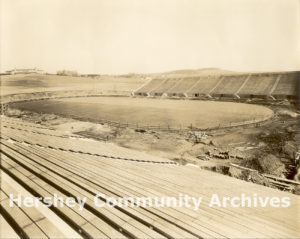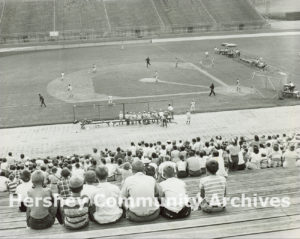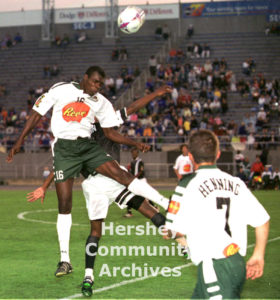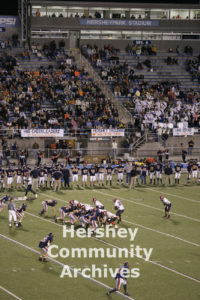Hershey Stadium

Hershey Stadium was the last major project of Hershey’s Great Building Campaign of the 1930s. Hershey’s construction program during the Great Depression provided 600 construction jobs and helped protect Hershey from the country’s economic collapse.
Hershey Stadium was completed in the Spring of 1939. It was intended to provide a venue for college, professional, and high school football games, as well as outdoor entertainment. The addition of the Stadium helped Hershey’s development of a greater sports center, joining the Sports Arena, four golf courses, and Hershey Park, which at that time included a baseball diamond and football practice field.
The Stadium could seat 15,360. Initially, there were plans to add a stand on the north end that would create a horseshoe with seating for 27,000. The stadium also boasted lighting that turned night into day. To create this effect, eight towers, 98 feet high, floodlighted the field with from 200,000 to 250,000 watts.
Starting May 18, the Stadium hosted Midget Auto Races every Thursday night. Later, Monday night races were added. Fans thronged to see the small, fast cars on the Stadium’s quarter mile track Midget auto races became a casualty of World War II as gas rationing made the races impractical. The Stadium was formally dedicated with a concert by the Allentown Band and a fireworks display on July 4th.
From the start, Hershey Stadium has been used by professional, collegiate, and high school football teams. A number of professional teams, including the Pittsburgh Steelers (1941, 1942, 1945, 1946), the Baltimore Colts (1947), the Boston Yanks (1948), the New York Bulldogs (1949), and the Philadelphia Eagles (1951-1967) held summer training camp in Hershey.
Many local people have fond memories of the Philadelphia Eagles, who made Hershey their summer training camp location for so many years. During their three week stay they could be seen throughout town. Living at the Community Building, the players made use of the building’s recreational facilities. Many local boys remember playing pool or handball with the football players. The players walked to and from the stadium and many residents have fond memories of watching practice and waiting outside to get autographs from their favorite players.
In 1958, the first “Big 33” game, which pitted the best high school players of East and West Pennsylvania against each other, was played at Hershey Stadium and Hershey continues to host the game each year. Since it was constructed, the Stadium has been used by the Hershey High School for its home football games. It also serves as the playing field for the annual Cocoa Bean Game, matching the town’s two high school teams, Hershey High School and Milton Hershey School against each other. The first game was played on November 20, 1943.
Given the broad scope of Hershey’s facilities, it’s not surprising that the first PIAA Football championship was held at the Stadium in 1988. After being held in Scranton for several years, the event returned to Hershey in 1998.
Over the years, many other groups have used the stadium. PA State Police Academy held its Rodeo at the Stadium beginning in 1934. The rodeo was an annual event until 1974. For many years, Drum and Bugle Corp competitions such as the Eastern States Championship were held annually featuring the best units in the northeast. The first ever such event was held July 22, 1939 and featured local American Legion and Veterans of Foreign Wars drum and bugle corps. In 1983, Hershey Foods hosted the Hershey’s National Track and Field Youth Program finals in Hershey for the first time, holding the competition at the Stadium. The Hershey Track and Field National finals were moved to the Milton Hershey School campus after Henry Hershey Field was constructed in 1984.
The Stadium allowed Hershey to host major events, attracting tens of thousands of people. In 1953, Hershey hosted the National Republican Party’s birthday party for President Dwight D. Eisenhower. Several events were held throughout the day as part of the celebration. In the Stadium, professional golfers, including Lew Worsham, Patty Berg and Ben Hogan, gave demonstrations. Six high school marching bands performed for the 12,000 to 14,000 people attending. President Eisenhower joined the stadium crowd for a fried chicken box dinner before joining a $100 a plate dinner being held in a big top circus tent, erected for the occasion.
The Stadium also hosted the very first AACA Antique Automobile Show in 1954. Since that first year, the Antique Auto Show has grown to a multi-day event and expanded out of the confines of the Stadium.
Beginning in the 1980s, Hershey Stadium emerged as a popular venue for large scale rock concerts. With seating on the ground, the venue offered space for up to 30,000 concert goers. In 1996, the Star Pavilion was developed to create a stage that could host audiences of 5,000 to 7,000. The Pavilion and the Stadium shared a stage and associated equipment, letting Hershey easily host a broad range of musical performers.
For five years, beginning in 1997, Hershey Stadium served as the home field for the Hershey Wildcats, an A-League soccer team. To provide the best possible playing surface, the Stadium is equipped with a new, state-of-the-art national grass field. In 2000, trying to build an audience for professional soccer, Hershey Entertainment & Resorts Company also hosted the first round of the Women’s Soccer Gold Cup international competition.
Today, the Stadium continues to be an important entertainment venue in Hershey. It continues to present several rock concerts each summer, serves as the home field for the Hershey High School football team, and is used for multiple events that require a large flat field and/or lots of seating in an outdoor venue.


